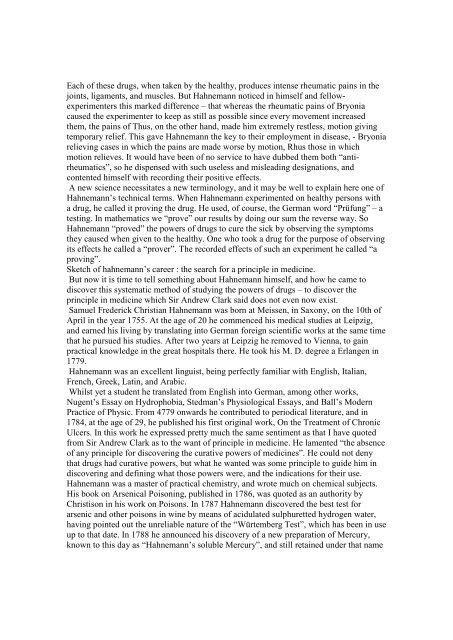CLARKE JH, Homoeopathy Explained - Classical Homeopathy Online
CLARKE JH, Homoeopathy Explained - Classical Homeopathy Online
CLARKE JH, Homoeopathy Explained - Classical Homeopathy Online
Create successful ePaper yourself
Turn your PDF publications into a flip-book with our unique Google optimized e-Paper software.
Each of these drugs, when taken by the healthy, produces intense rheumatic pains in the<br />
joints, ligaments, and muscles. But Hahnemann noticed in himself and fellowexperimenters<br />
this marked difference – that whereas the rheumatic pains of Bryonia<br />
caused the experimenter to keep as still as possible since every movement increased<br />
them, the pains of Thus, on the other hand, made him extremely restless, motion giving<br />
temporary relief. This gave Hahnemann the key to their employment in disease, - Bryonia<br />
relieving cases in which the pains are made worse by motion, Rhus those in which<br />
motion relieves. It would have been of no service to have dubbed them both “antirheumatics”,<br />
so he dispensed with such useless and misleading designations, and<br />
contented himself with recording their positive effects.<br />
A new science necessitates a new terminology, and it may be well to explain here one of<br />
Hahnemann’s technical terms. When Hahnemann experimented on healthy persons with<br />
a drug, he called it proving the drug. He used, of course, the German word “Prüfung” – a<br />
testing. In mathematics we “prove” our results by doing our sum the reverse way. So<br />
Hahnemann “proved” the powers of drugs to cure the sick by observing the symptoms<br />
they caused when given to the healthy. One who took a drug for the purpose of observing<br />
its effects he called a “prover”. The recorded effects of such an experiment he called “a<br />
proving”.<br />
Sketch of hahnemann’s career : the search for a principle in medicine.<br />
But now it is time to tell something about Hahnemann himself, and how he came to<br />
discover this systematic method of studying the powers of drugs – to discover the<br />
principle in medicine which Sir Andrew Clark said does not even now exist.<br />
Samuel Frederick Christian Hahnemann was born at Meissen, in Saxony, on the 10th of<br />
April in the year 1755. At the age of 20 he commenced his medical studies at Leipzig,<br />
and earned his living by translating into German foreign scientific works at the same time<br />
that he pursued his studies. After two years at Leipzig he removed to Vienna, to gain<br />
practical knowledge in the great hospitals there. He took his M. D. degree a Erlangen in<br />
1779.<br />
Hahnemann was an excellent linguist, being perfectly familiar with English, Italian,<br />
French, Greek, Latin, and Arabic.<br />
Whilst yet a student he translated from English into German, among other works,<br />
Nugent’s Essay on Hydrophobia, Stedman’s Physiological Essays, and Ball’s Modern<br />
Practice of Physic. From 4779 onwards he contributed to periodical literature, and in<br />
1784, at the age of 29, he published his first original work, On the Treatment of Chronic<br />
Ulcers. In this work he expressed pretty much the same sentiment as that I have quoted<br />
from Sir Andrew Clark as to the want of principle in medicine. He lamented “the absence<br />
of any principle for discovering the curative powers of medicines”. He could not deny<br />
that drugs had curative powers, but what he wanted was some principle to guide him in<br />
discovering and defining what those powers were, and the indications for their use.<br />
Hahnemann was a master of practical chemistry, and wrote much on chemical subjects.<br />
His book on Arsenical Poisoning, published in 1786, was quoted as an authority by<br />
Christison in his work on Poisons. In 1787 Hahnemann discovered the best test for<br />
arsenic and other poisons in wine by means of acidulated sulphuretted hydrogen water,<br />
having pointed out the unreliable nature of the “Würtemberg Test”, which has been in use<br />
up to that date. In 1788 he announced his discovery of a new preparation of Mercury,<br />
known to this day as “Hahnemann’s soluble Mercury”, and still retained under that name
















